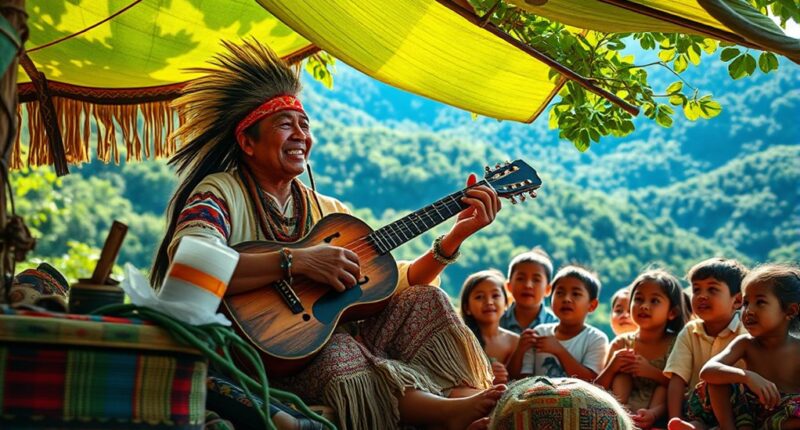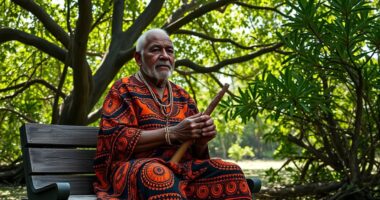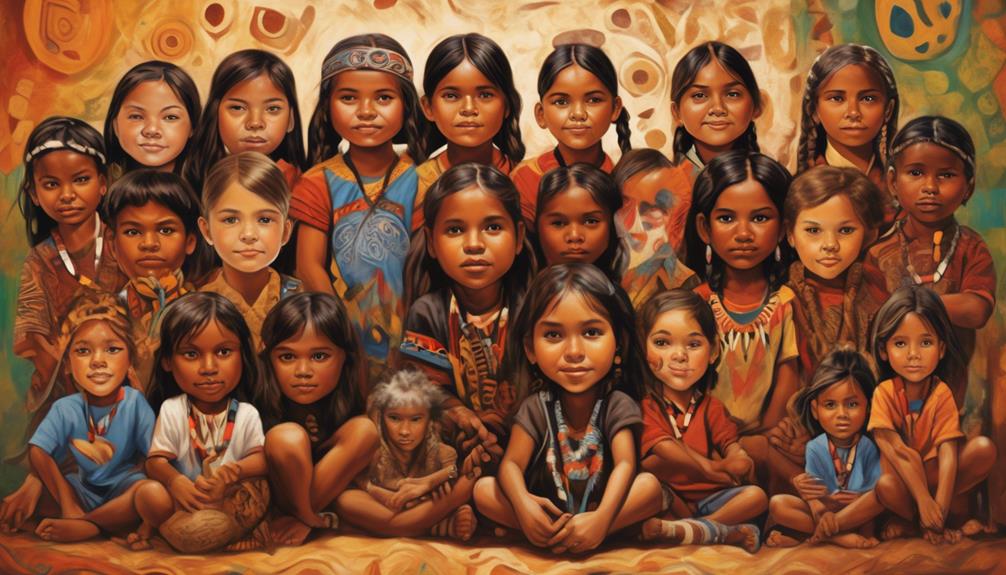Music can indeed help save a language by capturing its stories, teaching pronunciation, and inspiring pride within communities. When you participate in traditional songs, you make the language lively and relevant. Sharing songs globally allows others to appreciate its beauty and support preservation. Active involvement in musical traditions keeps the language alive for future generations. If you want to discover more ways music can strengthen cultural identity, keep exploring; there’s much more to uncover.
Key Takeaways
- Music preserves language by embedding traditional lyrics and melodies, making them memorable and engaging for future generations.
- Singing cultural songs encourages youth participation, fostering a sense of ownership and pride in their linguistic heritage.
- Incorporating traditional music into modern contexts revitalizes interest and keeps the language relevant and accessible.
- Sharing songs globally raises awareness, attracts support, and promotes respect for endangered languages and cultures.
- Active musical engagement strengthens pronunciation, intonation, and grammar, aiding language learning and retention.

Music and language are powerful tools for preserving cultural identity, especially as globalization and modernization threaten traditional practices. When communities face the erosion of their native languages, song becomes an essential means of linguistic revitalization. You might find that singing in your ancestral tongue helps keep that language alive, passing it from generation to generation. Songs encapsulate stories, values, and histories, making them a natural vehicle for maintaining cultural identity. Unlike spoken words that can fade or be forgotten, music leaves a lasting imprint, reinforcing a sense of belonging and pride within communities.
Songs preserve stories and identity, passing culture through generations long after words fade.
By integrating traditional melodies and lyrics into modern musical forms, you can breathe new life into old languages. This process not only encourages younger generations to learn and speak their heritage language but also fosters a collective sense of ownership. When you participate in singing cultural songs, you’re actively contributing to linguistic revitalization efforts. Music creates an emotional connection that words alone might not achieve, making language learning more engaging and meaningful. It transforms language from mere vocabulary into a living, breathing aspect of your identity.
Furthermore, music can reach beyond the borders of your community, spreading awareness and appreciation for your language on a global scale. When you share traditional songs through digital platforms or international performances, you showcase the beauty of your language and culture. This exposure can attract allies and inspire others to support language preservation initiatives. In this way, music acts as a bridge, connecting your community’s cultural identity with wider audiences, fostering respect and understanding.
You also play a pivotal role in this process by actively participating in musical traditions. Whether you’re singing at community gatherings, recording songs, or teaching your children traditional tunes, your involvement ensures that your language remains vibrant. Music’s rhythmic and melodic qualities make it easier to memorize and retain language, especially for young learners. As you sing, you reinforce pronunciation, intonation, and grammar, transforming language acquisition into a joyful experience. Your commitment to preserving musical and linguistic heritage strengthens the cultural fabric of your community.
In essence, music can truly save a language by making it relevant and accessible. It’s more than entertainment; it’s a form of cultural resilience. Through song, you help safeguard your community’s identity, ensuring that your language continues to thrive amid external pressures. When you embrace the power of music for linguistic revitalization, you keep your cultural identity alive, vibrant, and enduring for generations to come. Additionally, understanding the importance of cultural preservation can motivate communities to actively engage in these musical traditions to sustain their heritage.
Frequently Asked Questions
How Does Music Influence Cultural Identity Alongside Language?
Music influences cultural identity by fostering cultural pride and reinforcing shared traditions. When you engage with songs in your language, you strengthen your sense of belonging and connection to your roots. Music acts as a powerful tool, uniting communities and preserving unique expressions of identity. By singing or listening, you reinforce your cultural pride and keep your heritage alive, ensuring that your language and traditions continue to thrive across generations.
Can Traditional Songs Adapt to Modern Musical Styles Effectively?
Traditional songs are like ancient trees whose roots run deep; their adaptation to modern styles breathes new life into them. You can see musical adaptation as a bridge connecting tradition modernization with contemporary tastes, making old melodies relevant today. When you blend traditional elements with modern musical styles, you preserve cultural identity while engaging new audiences. This evolution guarantees that the essence of your heritage remains vibrant in a changing world.
What Role Do Digital Platforms Play in Language Preservation Through Music?
Digital platforms like streaming services and digital archives play a vital role in language preservation through music. You can access vast collections of traditional songs, making it easier to learn and share your language globally. Streaming services help popularize native music, encouraging younger generations to connect with their roots. By using these platforms, you actively contribute to keeping your language alive and vibrant for future generations.
Are There Successful Case Studies of Language Revival via Music?
You’ll find numerous successful case studies of linguistic revitalization through music. For example, communities use songs to revive endangered languages, turning cultural storytelling into powerful tools for preservation. These efforts inspire younger generations to engage with their heritage, helping keep languages alive. Music becomes a bridge, connecting past and present, ensuring that cultural stories continue to resonate and support linguistic revitalization efforts worldwide.
How Can Musicians Collaborate Across Cultures to Promote Endangered Languages?
Imagine discovering that your favorite song was born from musical diplomacy and cross-cultural fusion, uniting diverse traditions. You can foster this unity by collaborating with international artists, sharing stories, and blending musical styles to promote endangered languages. These cross-cultural projects create emotional connections, making listeners care deeply about language preservation. Your participation helps keep these languages alive, proving that music transcends borders and can revive cultural identities in powerful, inspiring ways.
Conclusion
Music acts like a bridge connecting generations, breathing new life into dying languages. When you embrace song as a vessel for language preservation, you’re planting seeds of cultural resilience. Just as a melody can echo through time, your efforts can keep a language alive, vibrant, and heard. Remember, every note you sing isn’t just music; it’s a powerful act of cultural preservation—turning silence into a symphony of survival.









